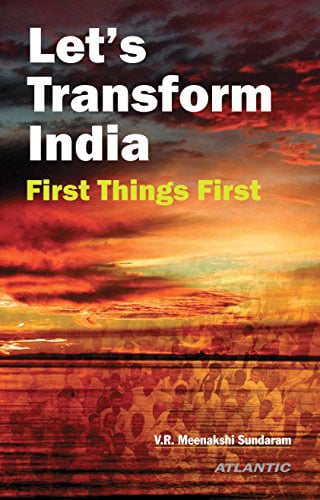SUBJECT: 5/5
RELEVANCE: 5/5
WRITING STYLE: 4/5
ENTERTAINMENT QUOTIENT: 4/5
[perfectpullquote align=”full” cite=”” link=”” color=”” class=”” size=””] “If we could first know where we are and whither we are tending, we could better judge what to do and how to do it.” – Abraham Lincoln [/perfectpullquote]
There are many times when we crib about the things that inhibit our country’s growth – corruption, inflation, coalition governments, crawling bureaucracy, protracted judiciary, rising crime, etc.
But we never do anything ourselves to take a positive step towards progress; we expect the government, our elected representatives, to do everything for us.
The funny thing is that most of us don’t even know what actually ails our country, but even then we crib.
Meenakshi Sundaram’s Let’s Transform India is a detailed enumeration of the things that impede our country’s growth – from colonial bureaucratic machinery to modern democracy – and suggests ways in which India can be put on a fast-track to progress.
The book begins at the root of our quandaries – colonialism, and its systems which were designed to rule the masses.
Meenakshi investigates each of the machinery independently – bureaucracy, judiciary, federal executive, the federal legislature, socialism, law enforcement, and corruption. The last sections are dedicated to discussing ideas for transformation.
The author explains how, many of our systems currently in practice, have been inspired by the colonial systems. He argues that diarchy which was developed by Britishers to rule India is still rampant at every level of governance – right from President/Prime Minister to Governor/Chief Minister to Gram Panchayat/Village Administrative Officer.
Meenakshi succinctly explains the irrelevance of such a structure and its financial burden on the taxpayers.
The plight of our judiciary is neatly elucidated – 32 million pending cases, the quantum of vacancy, the wild misuse of the highest courts for the paltriest of cases, etc.
“Another hindrance for the normal functioning of the courts appears to come from the high profile lawsuits. Almost in all such instances, after some drama and limelight, the cases get dismissed by the highest court in India, the Supreme Court. Can the officers of the lower courts not be enlightened about what constitutes a reasonable case so that valuable time of the courts do not go waste in pursuing constitutionally baseless and frivolous cases?”
Let’s Transform India is not a theoretical text-book for students of political science; it can very well be a handbook for the most serious of administrators and policymakers.
In fact, I have seen Narendra Modi implementing many of the ideas mentioned in the book – active participation of bureaucracy in policy implementation, shedding collective accountability by scrapping many of the central committees, emphasis on judicial reforms etc.
The ending section of the book which lists out the ideas for eliminating the rut and transforming India is practical and has been well explained.
I wish people at the highest levels of policymaking take notice of the book and implement at least a few of the ideas; it will bring about a drastic change in our country’s future. You should read it too.
Do let us know your feedback about the book or the review in the comments below.
